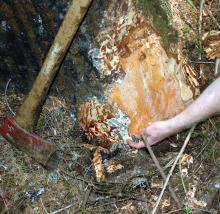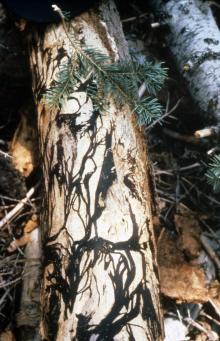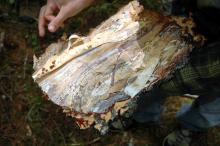Cause Armillaria ostoyae (may be referred to as A. solidipes in some publications) is the species associated with most conifer mortality in the Pacific Northwest, while A. mellea is considered rare.
This fungus occurs on the roots of many forest tree species. Douglas-fir, grand fir, white fir, and sugar pine can be severely damaged. Western larch and incense cedar are most resistant, while other conifers are intermediate.
In forests west of the Cascade Range, this disease is associated with stress conditions. Factors such as poorly planted seedlings, use of low quality, or off-site stock, contribute to disease development. The disease is common in Douglas-fir plantations between the ages of 10 and 25 years but uncommon in older stands. East of the Cascade Range, the disease may occur on 5-year-old trees and continue throughout the life of the stand. It is most common in eastern forests located in moist habitats.
The fungus can live many years as a saprophyte in soil, on infected stumps, roots, and other organic matter. It breaks down the lignin and cellulose in plant tissue. This fungus may form mushrooms at the base of infected trees in fall and winter. Mushrooms are honey-colored or light tan, with a stalk 4 to 6 inches or more in height and a cap 2 to 4 inches across, often dotted with brown scales. Spores are formed along the gills and are wind-blown. Spores are not a significant means of infecting healthy plants but can colonize old stumps and dead trees. The fungus spreads vegetatively along roots, which leads to the formation of groups of dead and dying plants called "disease centers." Centers may expand 1 to 3 feet per year and generally contain an infected old-growth stump. The fungus can survive on woody host roots long after the host dies. When infected trees are removed, infected roots that remain below ground serve as a source of inoculum for trees planted in the same location.
Symptoms This disease is characterized by thin and/or chlorotic foliage, distress cone crops, abundant resin flow or leaching of brown liquid at tree bases (basal resinosis) and tree death. Trees tend to die standing but may be wind thrown. Tree with lesion types that expand more vertically tend to survive and live longer than trees with lesion types that expand horizontally. Bark beetles may hasten tree decline and death. A yellow-stringy root and butt rot is common in non-resinous conifers such as hemlock. Diagnostic mycelial fans can be observed beneath the bark of the root crown of infected plants. Dig down about a foot below the soil line and use a pocketknife to remove thin layers of bark from the root collar. Mycelial fans are thick, white layers of fungus that adhere to the inner root bark and/or the wood beneath the bark. Armillaria also makes black, shoestring-like structures called rhizomorphs, which are occasionally found within the bark and/or extending into surrounding soil. Rhizomorphs may look like roots on the outside but have an entirely different structure when cut open in cross-section.
Cultural control
- Know where disease centers are likely to develop through historical records.
- Use seed sources adapted to the area. Supplement plantings using seeds that germinate on site.
- Favor resistant tree species by thinning mixed conifer stands.
- Cut trees out of infection centers plus a buffer of healthy appearing trees and establish resistant tree species.
- Avoid frequent salvage cuts in stands with known infection centers.
- Excavation of infected stumps can be considered where terrain, soil type and economics permit. Burn or let stumps air dry.
- In gardens, remove severely infected trees and destroy them, being careful to remove small roots from the soil. Replant with resistant species such as Ginkgo, Smoketree, catalpa, or larch (see the table "Plants Resistant or Susceptible to Armillaria Root Rot," in Section 3).
References Hadfield, J.S., Goheen, D.J., Filip, G.M., Harvey, R.D. 1986. Root Diseases in Oregon and Washington Conifers. USDA Forest Service Publ. R6-FPM-250-86. Portland, OR. 27pp.
Shaw, C.G. III, and G.A. Kile (eds.) 1991. Armillaria Root Disease. Washington, D.C.: United States Department of Agriculture Forest Service Agriculture Handbook No. 961. 233 pages.





